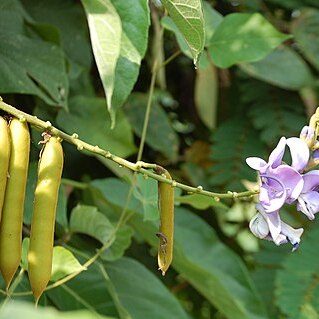Herbs usually twining, stems terete, strigulose. Leaves trifoliolate, leaflets rhomboid to ovate, apically acute, basally cuneate, stipellate, the stipules small. Inflorescences axillary racemes, the rachis elongate, the flowers 1-5 arising from tubercles on the rachis, the bracts caducous. Flowers with campanulate calyx, the lobes 5, the upper teeth united to apices; standard orbicular, auriculate, 2 callosites or elongated appendages on the inner face, the wing obovate, the keel falcate; stamens diadelphous, vexillary stamen free, the anthers monomorphic; style curved, flattened, the stigma capitate. Fruits broadly oblong to falcate, laterally compressed, beaked, seeds ovoid, black, hilum oblong with a white aril.
Herbs perennial, twining or suberect. Leaves pinnately 3-foliolate; stipules basifixed, reflexed, persistent; stipels lanceolate. Racemes axillary, nodes of rachis swollen. Calyx campanulate, 2-lipped, upper lip entire or emarginate, lower 3-lobed. Corolla purple or white; standard orbicular, reflexed, auriculate at base, with 2 callosities on inner surface; wings broadly ovate; keel incurved at right angle. Stamens diadelphous; anthers uniform. Style abruptly upturned, laterally compressed, bearded in upper part; stigma terminal. Legumes obliquely oblong-falcate, compressed, with minute warts along both sutures, shallowly septate between seeds within. Seeds slightly compressed, with white aril.
Corolla rather small, crimson, reddish-purple or white; standard round, usually reflexed, auriculate, with 2 callosities or appendages on the inner face; keel with beak incurved at a right-angle.
Ovary with several ovules; style with no narrow tenuous basal portion, stiffened, laterally flattened, slightly curved at the apex, hairy on the internal face; stigma terminal.
Pods oblong or oblong-falcate, tipped by the persistent style, sometimes with upper margin verrucose; septa spongy.
Inflorescences axillary, falsely racemose; peduncles long; rhachis swollen at the insertion of the pedicels.
Leaves pinnately 3-foliolate; stipules mostly reflexed and persistent; stipels lanceolate.
Calyx 2-lipped; tube campanulate; upper lip entire or emarginate, lower lip 3-lobed.
Seeds ovoid, compressed; hilum linear, with a whitish linear or hemispherical aril.
Vexillary stamen free or loosely joined; anthers uniform.
Suberect or climbing herbs.

